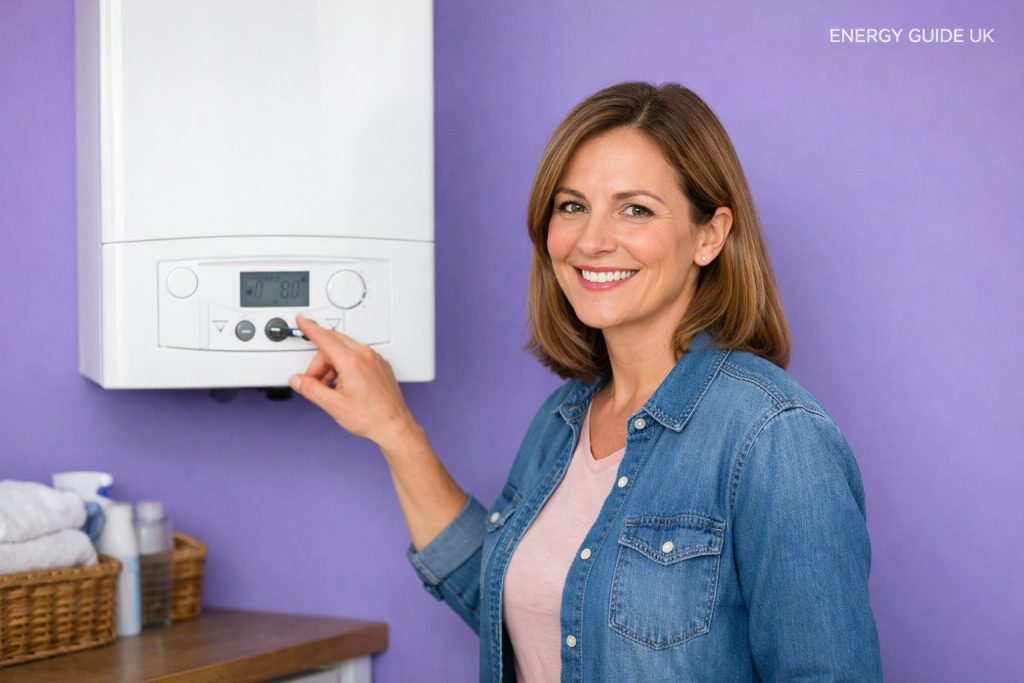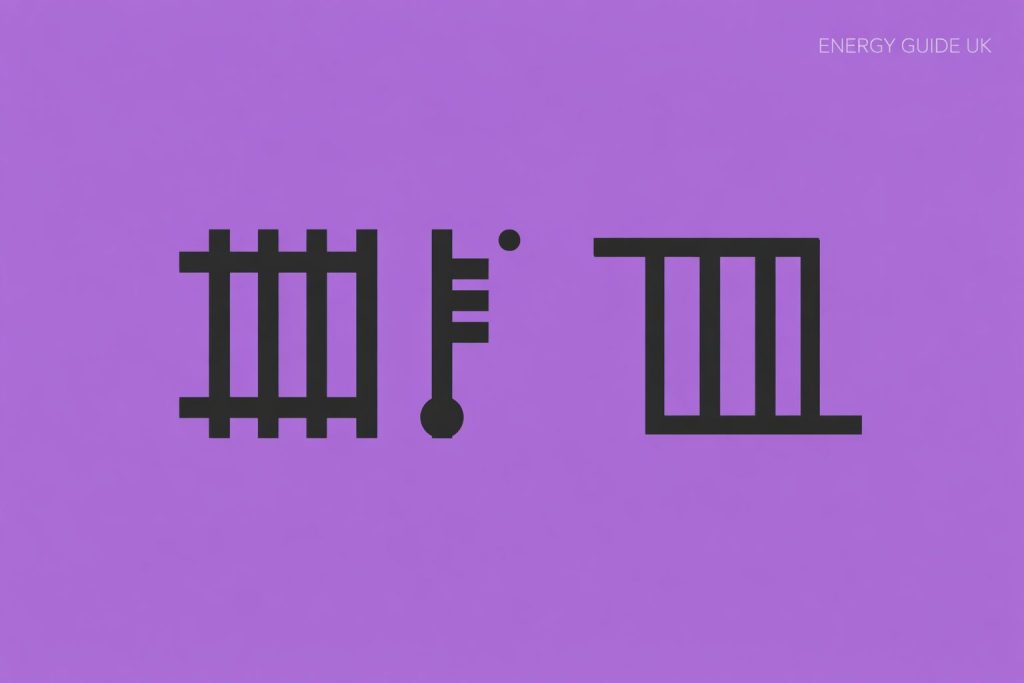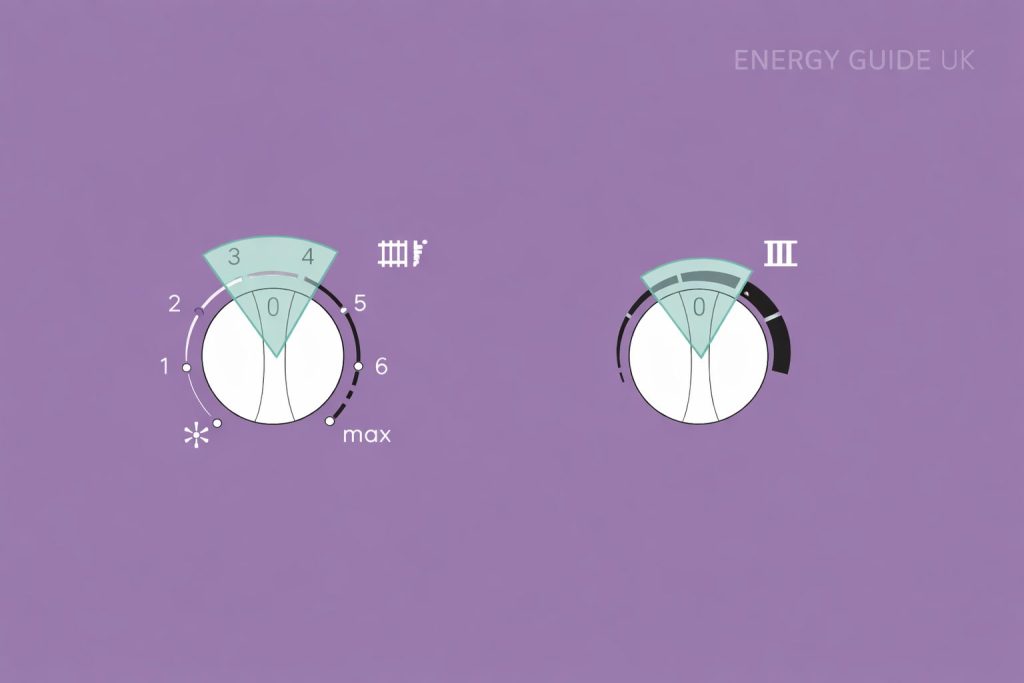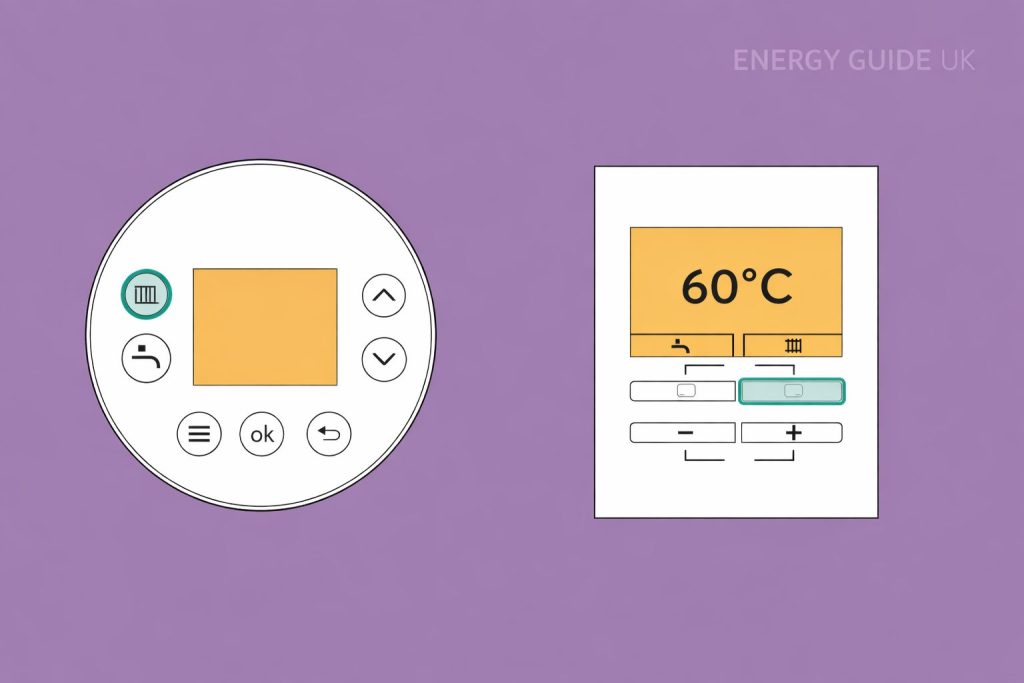What is the boiler flow temperature, and what settings can help you enhance efficiency and save money on heating bills?
Energy prices are still well above pre-energy crisis levels, and everyone is looking for easy ways to cut their energy bills, especially during the winter. One way to reduce your heating and hot water costs is to lower your boiler’s flow temperature.
According to the UK Government’s Clean Energy campaign, most boilers are set too high. Lowering the flow temperature to 60°C can make your boiler more efficient and help you save around £100 a year on energy bills.
Boilers are usually installed with conservative default settings that prioritise rapid heat delivery rather than everyday efficiency. Over time, that approach quietly increases gas use without improving comfort. Understanding how flow temperature works and knowing how to adjust it safely gives you a practical way to reduce energy use without changing your routine or investing in new equipment.

Key Takeaways on Boiler Flow Temperature:
- Boiler flow temperature controls heat delivery, not when the heating turns on. Thermostats manage timing; flow temperature manages intensity.
- The optimal flow temperature for most UK homes is 55–60°C for radiators, while hot water cylinders should remain at 60°C for hygiene.
- Lowering flow temperature improves efficiency by reducing fuel use, short cycling, and wasted heat, often saving around £100 per year.
- Homes vary, and poor insulation, small radiators, or older systems may require slightly higher temperatures. Gradual adjustments are safest.
- Safety is maintained as long as the hot water cylinder temperature remains separate from the heating flow temperature.
- Professional advice is recommended if radiators remain cold, systems are unbalanced, or upgrades are needed.
- A lower flow temperature makes your home future-ready and eases the transition to heat pumps or other low-temperature heating technologies.
What Is Boiler Flow Temperature?
Boiler flow temperature is the temperature of the water as it leaves the boiler and is sent around your heating system. It is a fixed operating setting within the boiler itself, determining how hot the water becomes before it circulates through radiators or underfloor heating.
This setting applies every time the boiler runs, regardless of how cold or warm your rooms feel. It does not respond to the thermostat, time schedules, or smart heating apps. Instead, it sets the upper limit on the amount of heat the boiler can deliver to the system at any given time.
In practical terms, flow temperature defines the intensity of heat available to your home. A higher flow temperature means hotter water entering radiators, allowing rooms to warm up more quickly. A lower flow temperature delivers heat more gradually, relying on longer circulation rather than short bursts of very hot water.
Most modern boilers, particularly condensing models, can operate efficiently over a wide range of flow temperatures. However, many are left at factory or installer defaults that prioritise speed over efficiency.
Why Does Boiler Flow Temperature Directly Impact Efficiency?
Boiler efficiency is determined by how effectively heat is transferred into your home, rather than by how hard the boiler works. Flow temperature plays a central role in that process, particularly in modern condensing boilers designed to recover heat that older systems allowed to escape.
When water returns to the boiler at a lower temperature, the boiler can extract additional heat from the exhaust gases before they leave the flue. This process increases overall efficiency and reduces the amount of gas needed to maintain indoor comfort. Higher flow temperatures raise the return temperature, limiting the amount of heat that can be recovered and pushing more energy out of the system as waste.
Lower flow temperatures also reduce short cycling, where the boiler switches on and off repeatedly. Research by the Building Research Establishment Ltd. (BRE) shows that frequent cycling increases wear and tear on your boiler and wastes fuel during start-up phases. A more moderate flow temperature encourages longer, steadier operating cycles that use fuel more efficiently.
Efficiency gains from flow temperature adjustment do not rely on sacrificing warmth. The same level of comfort can be achieved by delivering heat for longer at lower temperatures, which aligns more closely with how condensing boilers are designed to perform in real homes.
Recommended Boiler Flow Temperature Settings for UK Homes
The most efficient boiler flow temperature depends on the type of heating system you have and how well your home retains heat. There is no single setting that suits every property, but there are clear starting points that work for most UK households. Adjustments should be made gradually, allowing time to assess comfort before making further changes.
Best Practice Temperature Ranges
| Boiler Type / Situation | Recommended Flow Temperature | Notes |
| Combi boiler – central heating | 55–60 °C | Ideal for most modern homes with condensing boilers. Balances efficiency with consistent heat delivery. |
| System boiler – central heating | 55–65 °C | Slightly higher range accounts for homes with larger radiator systems or mild heat loss. |
| Older or poorly insulated homes | Up to 70 °C (temporary use) | It can be used during freezing periods. It should be reduced when temperatures moderate to avoid wasted energy. |
| Hot water (stored cylinders) | Minimum 60 °C | Maintains hygiene and prevents bacterial growth. This setting is separate from the central heating flow temperature. |
These ranges are guidelines rather than strict rules. Every home is different, and factors such as insulation, radiator size, and local climate can affect the ideal flow temperature. The goal is to maintain comfort while allowing the boiler to operate efficiently, avoiding unnecessary energy use.
How Much You Can Save by Lowering Boiler Flow Temperature
Reducing the boiler flow temperature can yield meaningful savings by reducing the amount of gas needed to maintain the same level of comfort. When a boiler runs more efficiently, less fuel is burned per heating cycle, reducing overall consumption throughout the heating season.
For many UK households, lowering the flow temperature from older default settings can improve efficiency by several percentage points. Evidence from Nesta shows that households could save about 9% on the total gas bill by reducing the flow temperature on their condensing combi boilers from 80°C to 60°C.
That improvement can lead to noticeable reductions in annual energy costs, particularly in homes that rely on central heating for extended periods during colder months.
The exact savings depend on factors such as:
- Insulation quality
- Radiator size
- Daily heating patterns
- Local energy tariffs
- What your boiler was set to before you made the change
- Whether your home was too warm before
- How much you experiment with your boiler’s flow temperature
Homes that already heat gradually and maintain stable indoor temperatures tend to benefit more than those that rely on short, intense heating bursts.
What makes flow temperature adjustment appealing is that it requires no new equipment and no change to daily habits. Once set correctly, the savings accumulate quietly in the background. Over time, even modest efficiency improvements can soften the impact of high energy prices without compromising comfort or convenience.
How to Adjust the Boiler Flow Temperature: Step-by-Step Guidance
Changing your boiler’s flow temperature is straightforward, but it should be done carefully to protect both efficiency and comfort. Most modern boilers allow adjustments via dials or buttons.
Ensure you’re standing in front of your boiler before you start and that you can clearly see the controls. It’s also recommended that you take a picture of your boiler controls and settings before proceeding so that you have a record of your initial settings.
Many boilers hide their controls behind a small flap. Look for a dial or button with a radiator or thermometer icon. Different manufacturers have slightly different symbols for central heating. They should look something like the examples below. Your boiler will most likely have this symbol next to a dial or button.

For Boilers with Multiple Dials:
- Find the dial nearest to the radiator symbol
- Turn this dial slowly downwards toward a setting around 60°C.
- If the dial isn’t numbered, aim for roughly the 12 o’clock position as a usable reference point, as shown in the images below:

Your digital display may update instantly to display the new flow temperature, which should be set to 60°C. If your display does not update immediately, it will update next time your heating is on. This is normal, 60°C is your boiler’s new target temperature, and it may take some time to reach this.
If Your Boiler Has A Single Dial:
- With just one dial, press the button with the radiator symbol to toggle to flow temperature mode.
- Once the display shows flow temperature, use the dial to reduce it to 60°C.
- Most boilers don’t display the temperature around the flow temperature dial, so aim to set it to roughly 12 o’clock.
For Boilers with Buttons Only:
For boilers with buttons only, the radiator symbol can be in several places. Two common control setups are below:

- To select the radiator flow temperature, press the button that has the radiator symbol on or near it. The display should then change to show the current flow temperature.
- Use the ‘down’ or ‘minus’ buttons to reduce the flow temperature to 60°C.
- Once the display reads 60°C, you may have to press the ‘OK’ or the radiator button again to confirm.
How Long to Wait Before Assessing Results?
Give your system at least 48–72 hours after changing the setting. Some changes you may notice include:
- Radiators may feel slightly cooler on the surface: This is normal, and most homes can be heated effectively with slightly cooler radiators.
- Rooms might take a little longer to warm up: As your radiators are cooler, your home will take slightly longer to heat up. This difference isn’t noticeable for many people.
- A reduction in gas use: Your boiler should now be running more efficiently. This will reduce the amount of gas it takes to heat your house, saving energy and money.
Got a common boiler problem? Check out our quick-fix guide to boiler lockouts, boiler ignition faults, boiler PCB faults, faulty diverter valves, and boiler timer issues.
What If Your Home Does Not Heat Properly at Lower Temperatures?
Lowering the boiler flow temperature works well for many homes, but some properties may feel slower to warm up after the change. This does not mean anything has gone wrong. It usually highlights how the heating system and the building itself respond to gentler heat delivery. Common reasons can include:
Radiator Sizing and Balancing
At lower flow temperatures, radiators release heat more gradually. If a system has been relying on very hot water to compensate for inefficiencies elsewhere, the reduction can expose those weak points. Rooms may still reach the desired temperature, but they may take longer than expected.
Radiators designed for higher flow temperatures may struggle to deliver enough heat when the water is cooler. In some cases, the issue is uneven distribution rather than radiator size. Poorly balanced systems send more hot water to some radiators than others, leaving certain rooms underheated. Balancing can often resolve this without raising the flow temperature.
Insulation Issues
Heat loss plays a significant role. Homes with limited insulation, draughts, or older glazing lose warmth faster than the system can replace it at lower temperatures. Improving insulation often has a greater impact on comfort than increasing boiler output.
A Slightly Higher Flow Temperature May Be Reasonable
Raising the flow temperature slightly during colder weather or in hard-to-heat homes is a practical adjustment, not a failure. The goal is efficiency, not rigid adherence to a number. Finding the lowest setting that keeps your home comfortable is a sensible and practical approach.
Boiler Flow Temperature vs Thermostat Settings
Flow temperature and thermostat settings are often confused because both influence how warm a home feels, but they operate at entirely different levels of the heating system. Understanding this distinction prevents wasted energy and frustration when adjusting controls.
How the Thermostat Controls Comfort
A thermostat measures the air temperature in your home and decides when to turn the heating on or off. Once the target room temperature is reached, it tells the boiler to stop supplying heat. It does not decide how hot the water inside the system should be.
How Flow Temperature Controls Heat Delivery
Flow temperature works independently of that decision. It determines how much heat is delivered each time the boiler is allowed to run. Even if the thermostat calls for heat, the boiler will only send water into the system at the flow temperature you have set.
Why Lowering Flow Temperature Does Not Reduce Comfort
Lowering the flow temperature doesn’t stop rooms from reaching the desired temperature. It simply changes how that warmth is delivered. Instead of short, intense bursts of heat, the system provides steadier output over a more extended period while the thermostat continues to manage comfort.
When both settings work together correctly, the thermostat controls when heating is needed, and the flow temperature controls how efficiently that heat is produced and distributed. Once both are aligned, the system delivers reliable warmth while using less energy, without the need for constant manual adjustment.
Seasonally Adjusting Boiler Flow Temperature
Boiler flow temperature does not need to remain fixed throughout the year. Adjusting it to suit seasonal conditions can improve efficiency while maintaining comfort as outdoor temperatures change.
Mild Weather and Shoulder Seasons
During spring and autumn, homes lose heat more slowly. Lower flow temperatures often provide enough warmth without strain on the system. These periods are ideal for testing reduced settings and finding the lowest comfortable temperature for your home.
Winter and Colder Conditions
In colder weather, particularly during prolonged cold spells, heat loss increases. A slightly higher flow temperature may be needed to maintain indoor comfort, especially in the morning and evening. Temporary increases during these periods are normal and practical.
Why Year-Round Maximum Settings Waste Energy
Leaving the flow temperature set high all year forces the boiler to work harder than necessary during milder months. This leads to unnecessary fuel use without improving comfort, as thermostats will still limit room temperatures.
You can adjust your boiler’s flow temperature periodically or as the weather changes. Small seasonal adjustments allow the heating system to respond to changing conditions while remaining efficient.
Your heating engineer can fit a weather compensation kit or a load compensator, which will change the flow temperature for you. You can only do this if you have a combi boiler, and the engineer will need to check if your boiler is compatible.
Doing this will give you the maximum possible savings from adjusting your boiler’s flow temperature and minimise the risk of your house not getting warm enough.
Is Lowering Boiler Flow Temperature Safe?
Lowering boiler flow temperature is widely considered safe when done correctly. Most concerns relate to hot water hygiene rather than the water used for central heating, and understanding the difference removes much of the uncertainty.
Hot Water Hygiene and Legionella Safety
Legionella bacteria, which cause Legionnaires’ disease, can develop in stored hot water if temperatures are too low for extended periods. For this reason, water held in a hot water cylinder should remain at 60°C. This temperature prevents bacterial growth and is recognised as a safety standard in UK homes.
Why Cylinder Temperatures Differ From Heating Flow Temperature
Central heating water and stored hot water serve different purposes. Heating flow temperature controls how warm radiators or underfloor systems become. Cylinder temperature controls the safety of water used for washing and bathing. Lowering heating flow temperature does not require reducing cylinder temperature, and the two settings should not be linked.
The Difference Between Tap Water and Radiator Water
Water circulating through radiators is part of a sealed system and never comes into contact with taps or showers. It is not used for drinking or washing. Adjusting flow temperature only affects this closed loop and has no impact on the safety of household tap water.
When these distinctions are understood and maintained, lowering boiler flow temperature is a safe and effective way to improve efficiency without introducing health risks.
Vulnerable People in the Household
You must consider the health and well-being of any household member who is vulnerable to cool temperatures. A lower flow temperature may cause rooms to heat up a little more slowly than before.
If the house gets too cold, it could be dangerous for older residents or people with health conditions such as asthma, heart disease, arthritis, osteoporosis, or fibromyalgia. They may require a higher-than-average room temperature, so you’ll need to set the flow temperature slightly above 60°C.
Boiler Flow Temperature and Heat Pumps
Lower boiler flow temperatures are not only about immediate efficiency. They also influence how prepared a home is for future heating technologies, particularly heat pumps, which operate very differently from traditional boilers.
Why Heat Pumps Rely on Lower Flow Temperatures
Heat pumps deliver heat at much lower water temperatures than gas boilers. They are designed to run continuously, supplying gentle, consistent warmth rather than short bursts of high heat. Homes already comfortable at lower flow temperatures are better suited to this style of heating.
What Lower Flow Temperatures Reveal About Your Home
If a property can maintain comfort with reduced boiler flow temperatures, it suggests that insulation levels, radiator sizing, and heat retention are working well. These same factors are essential for efficient heat pump performance.
Preparing for Future Heating Changes
Reducing flow temperature now can act as a practical test. It highlights areas that may need upgrades, such as radiator improvements or insulation, before switching to a low-temperature heating system.
Even without plans to install a heat pump, operating at lower flow temperatures encourages more efficient heating habits. This approach supports long-term reductions in energy use while keeping homes adaptable as heating technology evolves.
Have you heard about the gas boiler ban and are wondering what the alternatives to gas boilers are? Read our complete guide to replacing your gas boiler with a heat pump.
Quick Reference Table: Flow Temperature vs Outcomes
| Flow Temperature | Efficiency Level | Comfort Impact | Typical Use Cases |
| Around 75°C | Low | Rooms heat quickly, but the heat can feel uneven and short-lived | Older default settings, poorly insulated homes relying on rapid heat output |
| 65–70°C | Moderate | Faster warm-up with reasonable comfort | Cold weather use in older properties or homes with smaller radiators |
| 55–60°C | High | Steady, consistent warmth once rooms are up to temperature | Most modern UK homes with condensing boilers and standard radiators |
| 50–55°C | Very high | Slower warm-up, comfortable if heat retention is good | Well-insulated homes, larger radiators, heat pump-ready properties |
This table is intended as a practical reference rather than a rulebook. You can find the most effective flow temperature that works for you through trial and error. Ensure the setting you choose keeps your home safe and comfortable under normal conditions.
When to Get Professional Advice
While adjusting boiler flow temperature is usually straightforward, there are situations where expert guidance is essential to ensure safety, comfort, and maximum efficiency. Knowing when to call a professional prevents wasted effort and protects your system.
Signs a Heating System Needs Balancing
If some radiators heat quickly while others remain lukewarm, the system may be out of balance. Balancing ensures that hot water is distributed evenly, allowing your home to reach target temperatures without unnecessarily raising the flow temperature. Persistent uneven heating is a clear sign to seek professional help.
When Radiator Upgrades May Be Needed
Older or undersized radiators may struggle to deliver enough heat at lower flow temperatures. If rooms remain cold despite correct settings and good insulation, upgrading or adding radiators may be required to achieve comfort efficiently. A qualified installer can assess radiator size, placement, and compatibility with reduced flow temperatures.
Situations Where Installer Input Makes Sense
Professional input is advisable when your boiler is complex, digital, or app-connected, or if adjustments do not achieve the desired comfort. Installers can safely optimise flow temperature, advise on seasonal settings, and ensure that both efficiency and safety standards, including cylinder temperatures, are maintained.
Calling a professional is not a sign of failure but a proactive step to protect your home, maximise efficiency, and ensure the heating system operates reliably.
How old is your boiler? Should you consider a boiler repair or start looking at the latest boiler prices? It’s no secret that boiler efficiency deteriorates over time.
Final Thoughts on Boiler Flow Temperature
Adjusting your boiler’s flow temperature is one of the simplest ways to improve efficiency, reduce energy bills, and maintain a comfortable home. Small, careful changes can deliver noticeable savings without requiring new equipment or major lifestyle adjustments.
The key is understanding that flow temperature controls how heat is delivered, not when it is needed. Working alongside your thermostat, it allows the system to operate more efficiently while keeping rooms at a steady, comfortable temperature. Gradual adjustments, seasonal tweaks, and attention to radiator performance make the process safe, effective, and tailored to your home.
Flow temperature optimisation is a practical, low-risk step that puts you in control of your heating, improves energy efficiency, and saves money. With careful monitoring, occasional seasonal adjustments, and professional guidance when needed, it is possible to balance warmth, safety, and efficiency without compromise.
FAQs on Boiler Flow Temperature
What Is the Flow and Return Temperature of a Boiler?
The flow temperature is the temperature of the water leaving the boiler to circulate through radiators or underfloor heating. The return temperature is the temperature of the water returning to the boiler after it has released heat in the home. The difference between the two is essential to efficiency, especially in condensing boilers, as lower return temperatures enable greater heat recovery.
What Is the Normal Temperature for a Boiler?
For modern condensing boilers, the normal central heating flow temperature is typically 55–60°C, while stored hot water should remain at 60°C to maintain hygiene. Older boilers or poorly insulated homes may use higher temperatures, often around 70–75°C.
What Happens If the Boiler Flow Temperature Is Too Low?
If the flow temperature is set too low, radiators may not provide enough heat, rooms may take longer to warm up, and the boiler may run continuously. This usually indicates that the system needs balancing, radiator upgrades, or a slight temperature increase rather than a fault with the boiler.
What Happens If My Boiler Temperature Is Too High?
Excessively high flow temperatures reduce the efficiency of condensing boilers because the return water is too hot to allow condensation. This wastes fuel, increases bills, and can shorten boiler lifespan due to more frequent cycling. It may also cause radiators to feel uncomfortably hot.
What Should I Set the Boiler Flow Temperature To?
Most UK homes are comfortable and efficient with a flow temperature of 55–60°C for central heating. Hot water cylinders should remain at 60°C for safety. Adjust gradually and monitor comfort before making further changes.
Does Reducing Boiler Flow Temperature Save Energy?
Yes. Lowering flow temperature allows the boiler to operate more efficiently, reducing gas usage and short cycling. This can translate into noticeable reductions in energy bills over the course of a year.
Sources and References
- GOV.UK – Save around £100 on your energy bills
- GOV.UK – BRE Client Report
- Nesta – Money Saving Boiler Challenge: Supporting Evidence